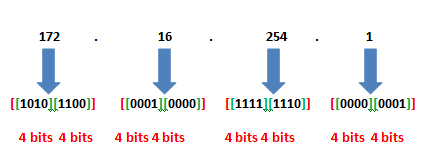In the ever-expanding realm of computer networking / IP Address Representation, understanding IP addresses and how they are represented is fundamental. An IP address, short for Internet Protocol address, is the cornerstone of communication on the internet. It’s how devices identify and locate one another. But what exactly is an IP address, and how is it represented?
Generally IP address is represented in 32-bit format. In expansion of IP is Internet protocol address.
Dot (.) is the decimal and this notation is used to represent as number format data into string of decimal each is separated by a dot operator. Technically this representation is noted as synonym of dotted notation. Or quad dotted notation, specifically used to represent IP addresses.
The Basics of IP Address – IP Address Representation
An IP address is essentially a unique identifier assigned to every device connected to a network. It allows devices to send and receive data packets, ensuring that information reaches its intended destination. IP addresses come in two primary versions: IPv4 (Internet Protocol version 4) and IPv6 (Internet Protocol version 6).
IPv4 vs. IPv6
IPv4, the more widely adopted version, uses a 32-bit format for its addresses. In contrast, IPv6 employs a 128-bit format. The transition from IPv4 to IPv6 became necessary due to the limited number of available IPv4 addresses. IPv6 was introduced to accommodate the growing number of devices connected to the internet.
IP Address Notation in IP Address Representation
IP addresses are commonly represented using a notation known as “dotted decimal notation.” In this format, the 32 bits of the address are divided into four 8-bit segments, each separated by a dot. Each segment is then converted into a decimal number ranging from 0 to 255. This representation is often referred to as “quad-dotted notation.”
In this blog I discussed about What is IP address and how to represent it.
An internet protocol address has 32-bits.
See the below example
These are separated by dot and the bits divided into 4 octets that are in decimal numbers ranging from 0 to 255 and concatenate together by place dot between them.
There are two types of IP Protocols implemented on systems today are IPv4 and IPv6. IPv4 is the 4th version majority of the systems worldwide support this. New version is IPv6 it improves the limitations of IPv4. The gap in version sequence between IPv4 and IPv6 resulted from the assignment of number 5 to the experimental Internet Stream Protocol in 1979, which however was never referred to as IPv5.
Systems can identify by using their IP address only.
For example consider the IP address 172.16.254.1
Convert these individual values into binary first
172 – 10101100
16 – 00010000
254 – 1111110
1 – 00000001
These are all can be represented in the form of 8 –bit
Each individual called as octet or byte or 8-bit. These are 4 so 4*8 = 32 so it is in 32 bit format.
Using binary arithmetic, it’s easy to calculate the highest number that a byte can represent. If you turn on all the bits in a byte (11111111) and then convert that byte to a decimal number
(128 + 64 + 32 + 16 + 8 + 4 + 2 + 1), those bits total 255.

The Significance of IP Address Representation
IP address representation is a critical aspect of computer networking. It allows devices to communicate effectively and ensures that data packets reach their intended recipients. Understanding IP address notation is essential for network administrators, developers, and anyone working with computer networks.
Conclusion – IP Address Representation
IP address representation plays a crucial role in the world of computer networking. Whether you’re dealing with the familiar IPv4 or the newer IPv6, the ability to interpret and work with IP addresses is essential for successful network operations. By demystifying the 32-bit format, dotted decimal notation, and binary conversion, you gain a deeper understanding of how devices communicate in the digital age.
Other article on Computers and organization are here.
IP addres wiki and other articel on IP address representation.
 IT2EDU Empowering Education Through Technology
IT2EDU Empowering Education Through Technology

